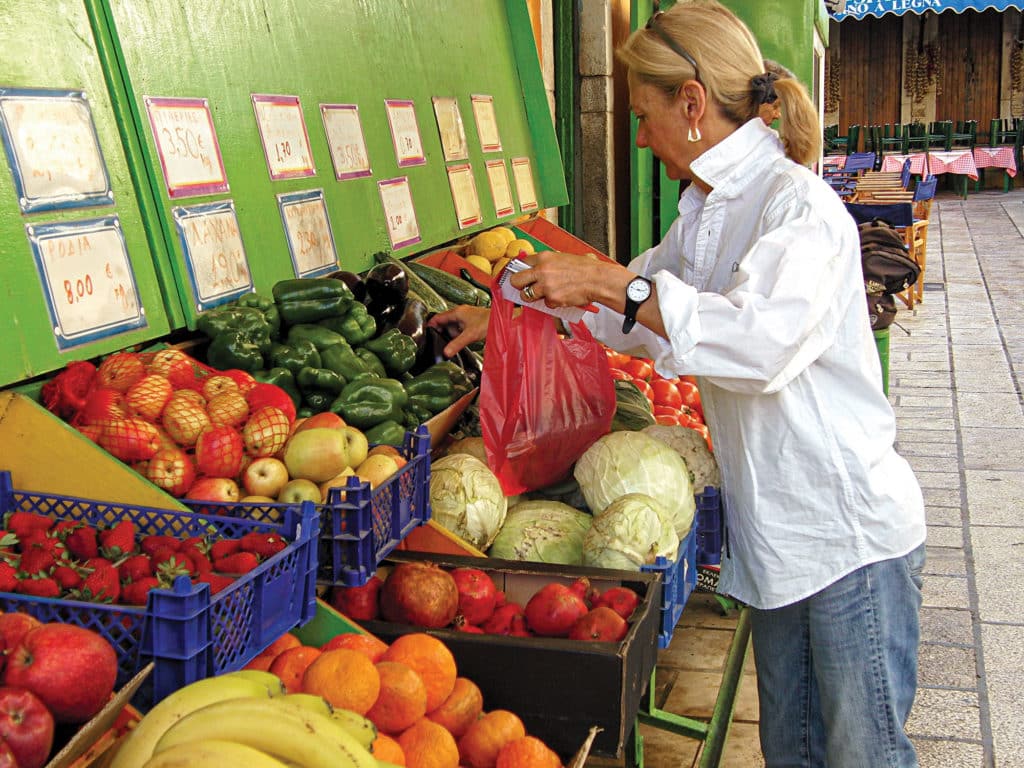
If you decide to self-provision before a bareboat charter, figuring out exactly what you need for a week on board, usually for multiple crewmembers with different food likes and dislikes, can be daunting. As a crewed-charter cook, I’ve provisioned for between four and seven guests every week during the sailing season for the past 20 years. Early on, I learned that for all to go smoothly, not cost a fortune and to avoid waste, I needed to plan daily meals in advance, then shop accordingly. Here are some tips. (For more general hints on provisioning for charters, see “Provisioning Made Easy”.
If you’re sailing with family, this is a job for the family cook. If you’re sailing with friends, choose one person to organize the menu and food-shopping list—you can easily share the actual shopping and meal prep once you’re all at your destination and aboard. In general, keep meals (and recipes) simple, using ingredients that can be found almost anywhere. For breakfast, remember that everyone will be eager to get sailing, and sumptuous cooked breakfasts take time. (Plus, not everyone will rise at the same hour—you’re on vacation!—and there’s nothing worse than cold scrambled eggs.) Continental “buffet” breakfasts are the way to go: fruit, granola, yogurt, muffins or sweetbread (store-bought are fine), even bread and butter with jam—plus a pot or two of coffee—and you’re good to go.
On charters in Greece, we follow local tradition and eat a light cooked lunch with salad most days; this is often easier than making sandwiches for a crowd. On rough days, pre-made sandwiches do fit the bill—use whatever’s available locally. Tortilla wraps can easily be made in advance, and when individually wrapped in wax paper or plastic wrap, they will store well in the fridge until lunchtime. In the evening, we generally head ashore to a local island taverna for a meal, but whenever we do eat dinner aboard, to avoid heating up the boat with the stovetop or oven, generally we turn to the trusty transom barbecue: grilled fish, chicken, steaks or burgers with a small appetizer, fresh bread, and a big salad or two.
Ready to get started? Here are a few of my tips:
Gather food preferences. Unless you’re sailing with family and you know everyone’s likes and dislikes, not to mention appetites, email your crew a few quick, simple “food-preference” questions. Include basic questions such as appetite level (small, medium or large), food allergies and items anyone hates or will not eat. Do people want tea or coffee? What kind? Decaf or regular? Then ask specifics about what kind and how many drinks people want aboard (water, soda, beer, wine, booze, mixers). Include snack preferences: chips, nuts, crackers, cheese. And so on. Ask them to take five minutes to fill it out, save it (or snap a photo) and email it back to you. Remember: A major reason for food waste is buying items your crew either doesn’t like or won’t eat.
Plan the week’s menu: breakfast, lunch, dinner (or whichever daily meals you’ll eat on board). Once you have your mates’ preferences in hand, plan a menu for the week: breakfast, lunch and/or dinner for each day. If you’re chartering for a week, estimate how many days you’ll actually eat every meal on board, and how many days you’ll head ashore for dinner. Keep in mind that the first and/or last days of your charter might not require all meals aboard, depending on where you sail. Keep meals—even cooked ones—uncomplicated and easy to prepare on board. Next, on a blank piece of paper, make a simple grid, as shown in the photo on page 80. To keep it simple, do it by hand. Write in the days of your trip (Saturday through Friday, for example). Fill in daily breakfast buffet items at the top. Then, for each day, on the left, fill in your menu for lunch and/or dinner. Leave the last full day of the charter blank. On the right, list all the ingredients you need to buy for each day’s meals—all ingredients, right down to the condiments you’ll need if sandwiches are on the lunch menu. For dinners or cooked lunches, it helps to have your recipes in front of you while you do this, unless you know them by heart.
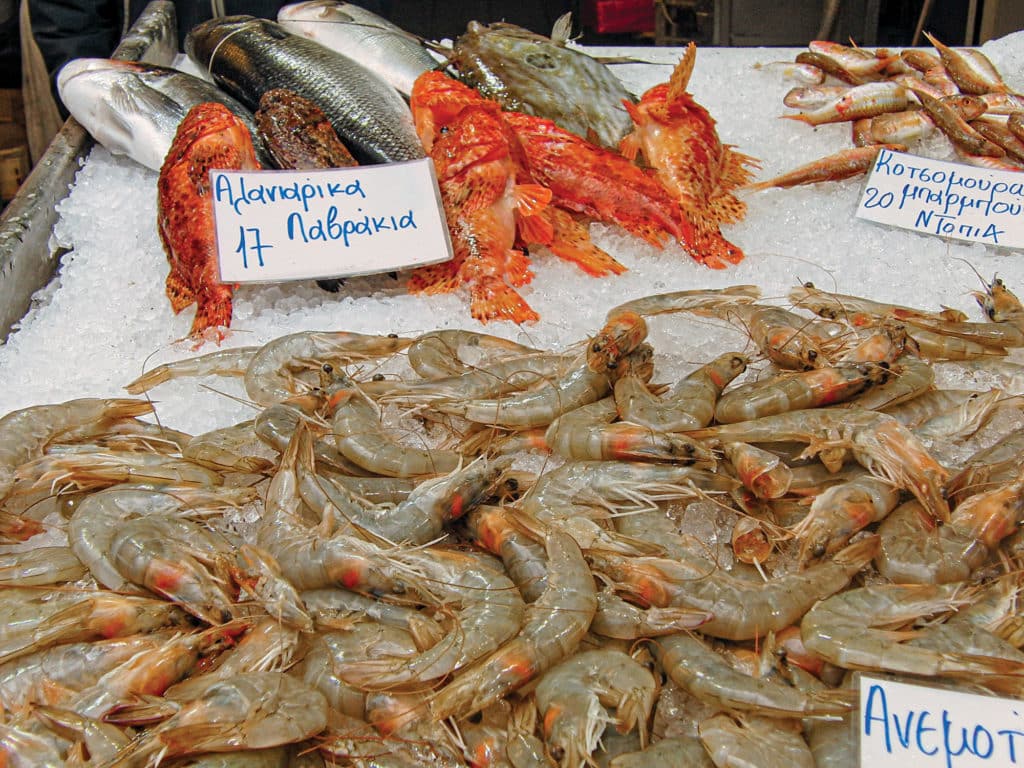
Of course, once you’re there, you can mix up the order of meals, but this ensures you have all the ingredients you need on board. Store your recipes on your phone or tablet or print them out and bring them with you—that way people can take turns cooking. If you need herbs or spices, to save money and avoid waste, either bring your own (there are travel spice kits available online) or buy fresh, if available. (This is my preference. I always include fresh parsley, sage, rosemary, thyme and oregano.) Depending on the boat, you might even need to add salt and pepper to your spice list. Now you’re halfway there.
Make your master grocery list. This is easier to do on a laptop, which makes it simple to add, delete, cut, copy and paste. Impulse shopping with a bare-bones list or no list at all is the biggest reason for wasted food at the end of a charter (not to mention added expense). Use your menu plus your crew’s food preferences to make your master list. Finally, add basic staples such as napkins, paper towels, facial tissue, toilet paper and cleaning supplies (such as dishwashing liquid, sponges and all-purpose spray cleaner). It’s helpful to categorize the list (meat/seafood, produce, drinks, dry goods, dairy, cleaning supplies), which will save you lots of time at the grocery store.
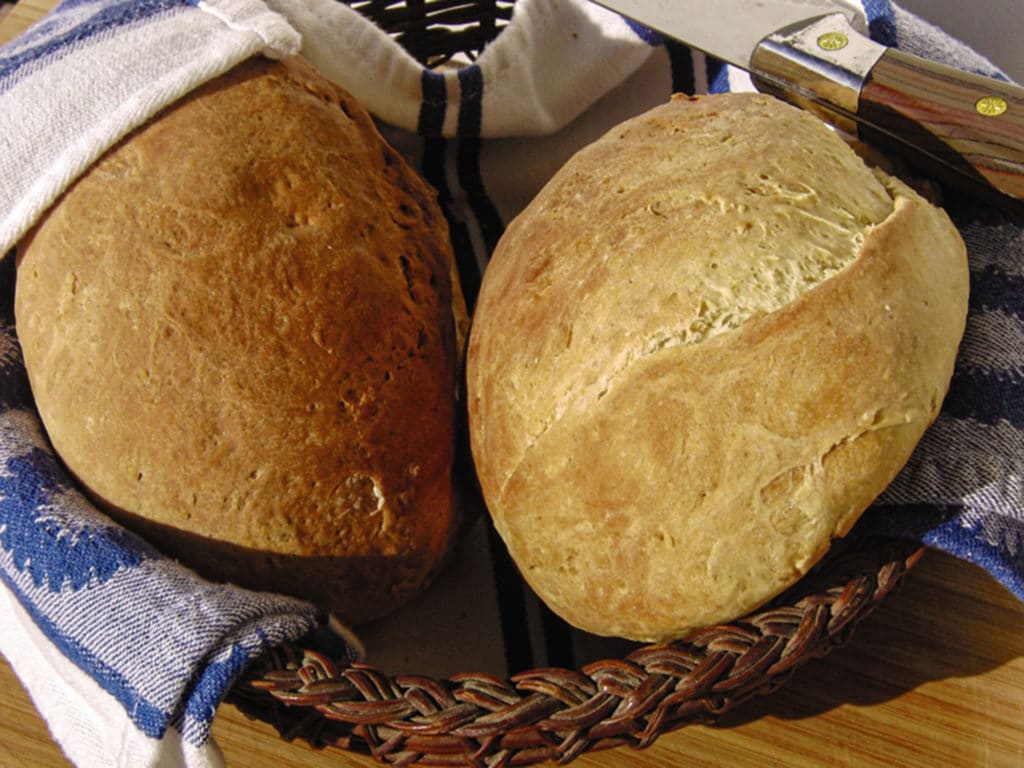
You’re almost ready to go sailing! Once you’ve arrived at your destination, your list will make provisioning quick and hassle-free. If you do run out of something as you go, most charter destinations have either large or small markets in various ports, making topping up odds and ends (or sampling local delicacies) easy and fun. In Greece, even tiny islands have a local bakery—fresh bread and/or pastry on demand!
At charter’s end, get creative. Mealwise, I call the last full day of a charter a “Joker Day”—short for: “Let’s use up everything we have left.” On the last day, usually I serve impromptu meals using odds and ends still left in the fridge or storage lockers. Sailors are a resourceful lot; you’d be surprised by the delicious meals you can make by amassing and assessing all the stray items lingering at the end of a charter week.
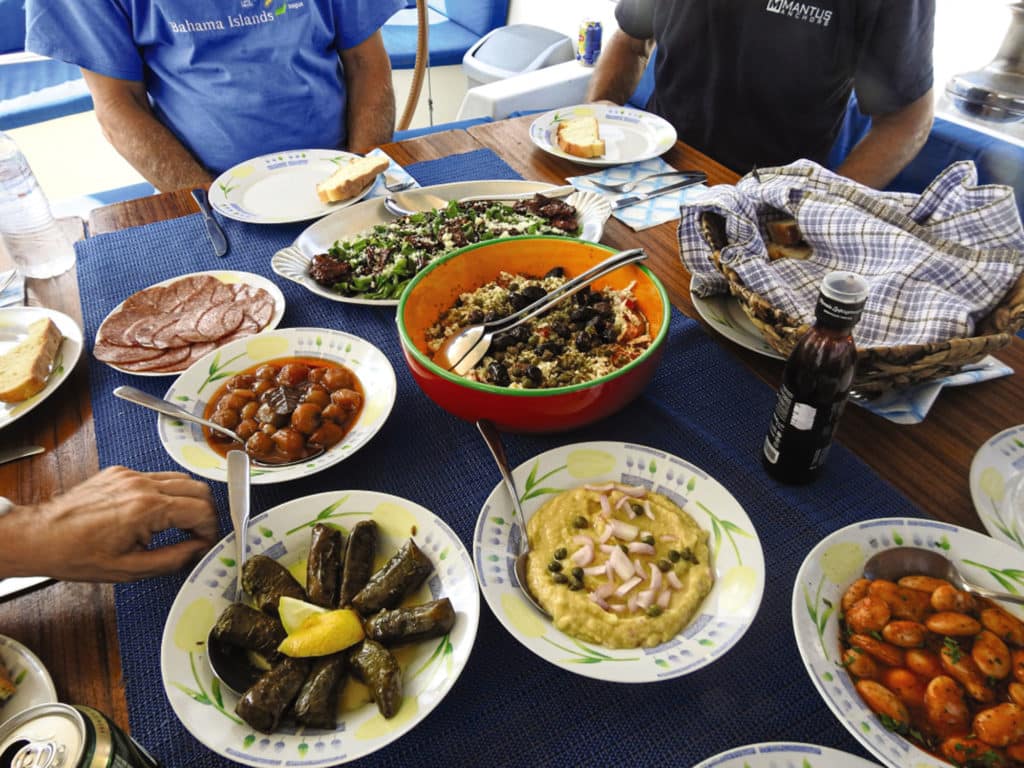
Got leftover bread, milk and a few eggs? Splurge and make a big breakfast on your last day. French toast is an easy option, or make a bread-crusted quiche: Oil an ovenproof dish, tear bread into small pieces, and press to the bottom. Drizzle generously with melted butter. Beat eggs with a dash of milk or cream, add salt and pepper, then stir and pour over bread to cover. Top with grated cheese, if you have it. Bake at 400 degrees for 15 to 20 minutes, or until eggs are set. No bread? No problem. Skip it, and just make baked eggs—like a crustless quiche.
If you have a few stray pieces of fruit still lingering —grapes, melon, bananas, pineapples, berries, kiwi—slice or chop and toss together to make a simple fruit salad; any combination will do. If you have lemons or limes, squeeze juice over fruit, add a drizzle of honey, and stir to combine; otherwise, just slice and serve.
Leftover pasta? Cook it up and make pasta salad. You can add chopped bits of stray onions, celery, tomatoes, green peppers; just about any kind of cheese; sliced turkey or ham—even items like that half-jar of pickles or olives in the fridge. Add some mayo, bottled vinaigrette or just oil and wine vinegar, salt and pepper to taste, then stir, and you’re good to go.
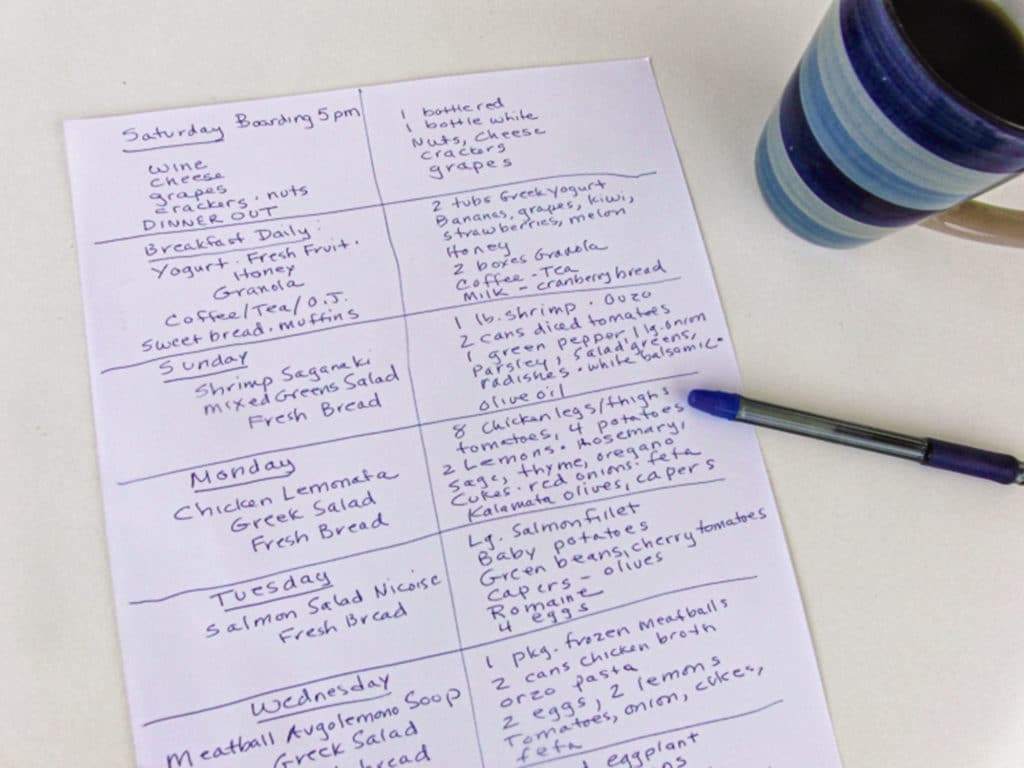
If you’ve got canned or jarred treats lingering—such as marinated artichoke hearts, asparagus spears, roasted peppers or olives—arrange them on small individual plates, garnish with whatever herbs you have left, and enjoy with fresh bread (if available) as a last-day lunch. In Greece, this variety of small plates are called mezedes, otherwise known as tapas. If you have eggs, add these: Just hard-boil, peel, slice into quarters, and arrange on a small plate. Add salt, pepper, a splash of red wine vinegar and a bit of oil, stray capers if you have them, and you’ve got another plate. Ditto with stray bits of cheese, salami, tomatoes or cucumbers: Cut, slice, and make a plate. Fresh veggies—such as carrots, peppers, zucchini, eggplant or mushrooms—can be sliced or julienned and marinated for a few hours in bottled or homemade vinaigrette to make a marinated-veggie platter. Alternatively, toss with oil, salt and pepper, and roast for 20-25 minutes at 390 degrees F, and you have delicious roasted vegetables. Raw carrots or zucchini, cut into sticks, can make a small raw-veggie platter. For dips: If you have a bit of mayo left, add a squeeze of lemon or lime. If your spice kit includes curry powder, mix mayo with a shake of curry, and stir for a dip with zing. You can even mix leftover ketchup and mayo for a simple thousand-island dip.
Stow wisely: At the boat, consider keeping similar items together, and stacking meats in the fridge or freezer in the order they will be used. Keep snacks and drinks where everyone can find them.
The possibilities are endless, and will differ in every sailing location. The trick is to evaluate what you have, then get creative. Besides, there are few foods that aren’t satisfying when consumed while swinging on the hook in a stunning harbor in your chosen vacation paradise.
That’s it! All it takes for easy, stress-free culinary success on charters—with no leftovers—is a little preplanning with a dash of creativity.
Lynda Morris Childress and her husband, Kostas Ghiokas, have sailed and chartered their Atlantic 70 cutter, Stressbuster, in the Greek Islands since 2003.








